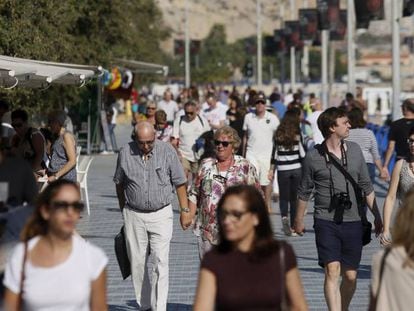Why Spain is still failing to attract high-end tourists
New study encourages sector to look to the long-term and “unashamedly” target wealthier visitors

Spain is on track for a record year of overseas tourists, with official forecasts predicting 74 million foreigners will have visited the country by the end of 2016, but 90% of them will be thrifty Europeans looking for a low-cost stay in the sun. Spain is still not making much of an effort to attract more visitors from Asia and the Middle East, nor has it been successful in selling itself as a desirable destination for wealthier visitors from the United States and Europe.

The industry can only look on as other countries scoop the lion’s share of the high-end global tourist market –the Chinese, US and Saudi tourists with extravagant holiday spending habits. If Spain does want a share of the spoils, says a new study by Ernst & Young, it will have to begin “unashamedly” targeting these markets with a coordinated game plan.
Saturation is a surefire way of wearing a destination out Ernst & Young
With this in mind, the consultancy calls for more spending on marketing, better coordination between government agencies and a change of strategy to package Spain as offering more than just sunshine, beaches, bullfighting and parties.
It points out that Europeans make up 89.4% of the total number of visitors, but that they spend on average just €135 a day. Moreover, the average tourist in Spain is spending less, a trend only compensated for by the increase in numbers. Instead, it is non-European visitors who are likely to pump cash into the wider economy, says Ernst & Young, noting that the average Chinese tourist spends an average of €960 on each shopping-focused trip, while visitors from Hong Kong spend more than €1,000, and the US traveler, €672.
On the basis of this data, the report advises the industry to “give Spain’s image a makeover as a tourist destination, marketing it to high-end clients, which will allow for more substantial revenue”. In other words, Spain needs to sell itself as a premium destination, targeting new markets and shifting the focus away from the UK and Germany.
Of the 116 million Chinese who took overseas holidays in 2015, only 0.3% came to Spain; of the 68 million US nationals on the move, that figure was 2.6%. Madrid has just 16 flights a week to China, while it has 68 to Paris, 66 to London and 62 to Frankfurt.
The study also points out that for every tourist euro spent on duty free goods in Spain, €7.3 are left behind in Paris and €6.2 in London. Spain’s luxury goods sector is described as “still very basic”, and the sector is advised to “adopt a strategy that will unashamedly attract the premium-profile tourist.” The report urges the creation of more exclusive offers, with services adapted to the needs of specific countries and the establishment of a chains of luxury hotels, such as the US Four Seasons brand.
Low-spending Europeans make up 90% of visitors to Spain
Identifying new promotional tools, including more investment in online strategies, strengthening coordination between regional governments, working more closely with the private sector and increasing spending on advertising, the study came up with ideas to inform non-European tourists of Spain’s other qualities.
It also noted that the budget for Turespaña, the organization tasked with promoting Spain as a tourist destination abroad, fell from €224 million in 2009 to €91.7 million in 2016, with just 40.6% invested in advertising.
Similarly, in a country where tourism accounts for 11% of GDP and 12% of employment, investment in tourism is relatively low – the Canary Islands invest just 0.9% of its overall budget on tourism, even though the sector accounts for 31.2% of its GDP.
Finally, the report accuses Spain of complacency, in part due to having been chosen by visitors wary of destinations in the southern Mediterranean. It notes shortfalls in key areas such as cleanliness, safety, information technology, and language skills, while pointing out that in some cities visitor numbers are becoming unsustainable: in Barcelona, at any given time there are 4.4 tourists for every resident, and that’s without counting cruise-liner passengers or people staying in Airbnb-type apartments. Ernst & Young says the city is so overwhelmed that it faces the danger of residents moving out of the city center, which in the long-term would make Barcelona less attractive. “Saturation is a surefire way of wearing a destination out,” it concludes.
English version by Heather Galloway.












































